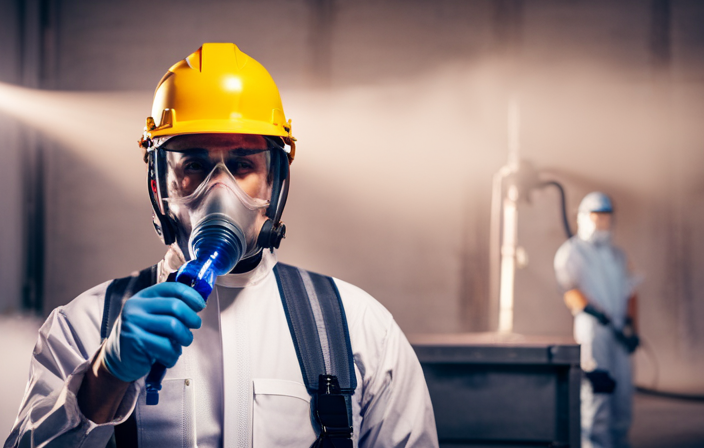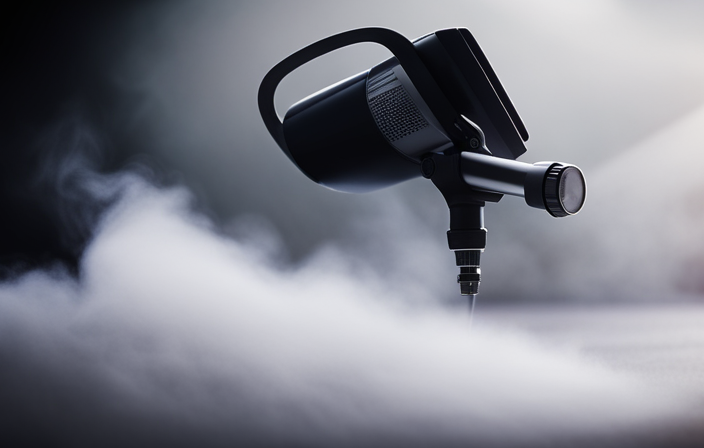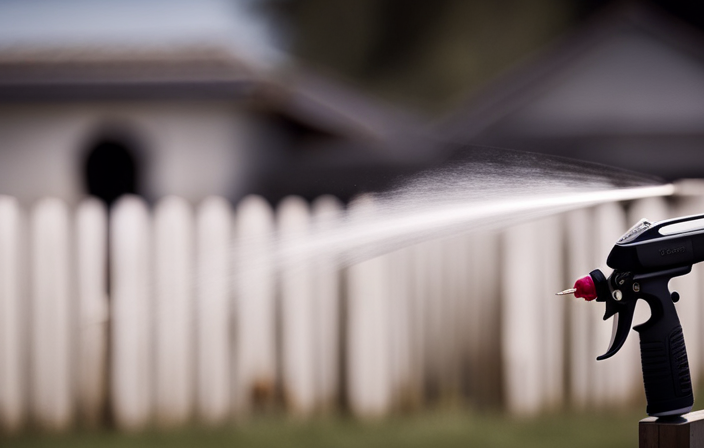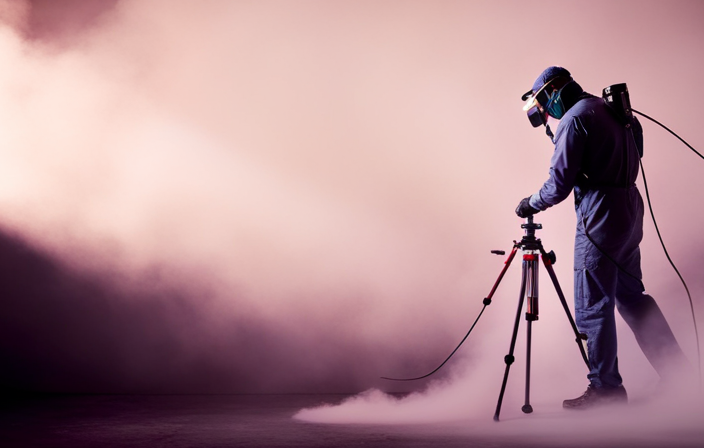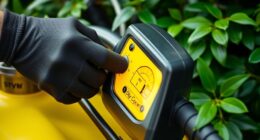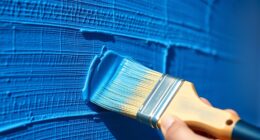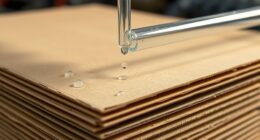I have always believed that painting requires careful attention to detail and skill. But what if I told you there is a simple technique that can improve the quality and efficiency of your painting projects? Welcome to the world of thinning paint for airless sprayers. Mixing water with paint may seem strange at first, but trust me, it will change the way you work.
In this article, I will guide you through the process of determining the right water-to-paint ratio for your airless sprayer. We’ll explore the benefits of diluting paint, common mistakes to avoid, and safety precautions to take.
Whether you’re a seasoned painter or just starting out, this knowledge will elevate your painting skills to the next level.
So, grab your paint cans and let’s dive into the world of diluting paint for airless sprayers. Get ready to achieve that smooth, even application you’ve always dreamed of!
Key Takeaways
- Measure 5 gallons of paint and pour into a bucket
- Slowly add water while stirring continuously
- Refer to manufacturer’s instructions for water amount
- Add water in small increments until desired consistency
Importance of Diluting Paint for Airless Sprayers
When using an airless sprayer, it’s crucial to dilute the paint properly to ensure a smooth and even coat. This will allow the paint to effortlessly glide onto the surface like a gentle rain shower on a warm summer day.
Diluting the paint with the right amount of water is essential for achieving even coverage and preventing clogs in the sprayer. The water-to-paint ratio will depend on the specific type and brand of paint you’re using.
Generally, a good starting point is to add about 10% water to the paint for an airless sprayer. However, it’s always recommended to consult the manufacturer’s instructions or test a small sample first to determine the ideal ratio for your particular paint.
Understanding the water-to-paint ratio is key to achieving professional-quality results with your airless sprayer.
Understanding the Water-to-Paint Ratio
When it comes to diluting paint for airless sprayers, it’s important to understand the water-to-paint ratio. One key point to consider is the different types of paints and their recommended water amounts. This ratio can vary depending on the type of paint being used, so it’s essential to follow the manufacturer’s guidelines.
Additionally, there are factors to consider when determining the ratio, such as the desired consistency and the specific application method. By understanding these key points, you can ensure that you achieve the best results when diluting paint for airless sprayers.
Different Types of Paints and Their Recommended Water Amounts
To achieve the perfect consistency, you’ll want to add the recommended amount of water to different types of paints, such as latex or acrylic.
It’s fascinating to note that adding just 10% water to latex paint can increase its coverage by up to 25%.
When it comes to diluting paints, each type has its own recommended water ratio. For example, latex paint typically requires a 10% water addition, while acrylic paint may need a 20% water addition. These ratios ensure that the paint flows smoothly through the airless sprayer and provides optimal coverage.
It’s important to follow these guidelines to avoid issues like clogging or insufficient coverage.
Now, let’s delve into the factors to consider when determining the ratio, ensuring you achieve the best results with your airless sprayer.
Factors to Consider When Determining the Ratio
Determining the perfect ratio involves considering various factors that’ll ensure you achieve flawless, professional-looking results with your paint application. There are three key factors to consider when determining the ratio of water to add to your paint for an airless sprayer:
-
Paint Thickness: Different paints have different levels of thickness, so it’s important to adjust the water ratio accordingly. Thicker paints may require more water to achieve a smooth consistency.
-
Sprayer Nozzle Size: The size of your sprayer nozzle will also affect the ratio of water to paint. A smaller nozzle size may require a higher water ratio to prevent clogging and ensure an even application.
-
Environmental Conditions: The temperature and humidity of your work environment can impact the drying time and flow of the paint. Adjusting the water ratio based on these conditions can help achieve optimal results.
By considering these factors, you can achieve a smooth and even application with your airless sprayer. Now, let’s explore some tips for achieving a flawless finish.
Tips for Achieving a Smooth and Even Application
For a flawless finish, it’s essential to follow these tips to ensure a smooth and even application of paint.
First and foremost, achieving even coverage is key. To achieve this, it’s important to maintain a consistent distance between the sprayer and the surface being painted. Moving the sprayer too quickly or too slowly can result in uneven coverage and streaks.
Additionally, it’s important to avoid applying too much paint in one area, as this can lead to drips and an uneven finish. Instead, apply thin layers of paint, allowing each layer to dry before adding another. This will help prevent drips and ensure a smooth, even coat.
Lastly, make sure to clean the sprayer thoroughly before and after each use to avoid any paint residue clogging the nozzle. By following these tips, you’ll be on your way to a professional-looking paint job.
Now, let’s explore the benefits of diluting paint for airless sprayers.
Benefits of Diluting Paint for Airless Sprayers
One major advantage of diluting paint for airless sprayers is that it helps achieve a smoother and more consistent application. Thinning paint before using an airless sprayer has several benefits.
Firstly, it improves the flow of the paint, allowing it to spread evenly and smoothly on the surface. This helps to avoid streaks, drips, and uneven coverage.
Secondly, it helps to prevent clogging in the spray gun, ensuring a continuous and uninterrupted spray pattern. The recommended water to paint ratio for dilution can vary depending on the type and brand of paint, but a common guideline is to add about 10% water to the paint. However, it’s important to follow the manufacturer’s instructions for the specific paint being used.
By diluting paint properly, you can achieve a flawless finish and save time on touch-ups.
Now let’s move on to common mistakes to avoid when diluting paint.
Common Mistakes to Avoid When Diluting Paint
To ensure a flawless finish, it’s crucial to steer clear of common blunders when thinning your paint for optimal application with an airless sprayer. Achieving smooth application is the ultimate goal, and avoiding these common mistakes will help you achieve that.
| Common Mistakes | Tips to Avoid |
|---|---|
| Adding too much water | Gradually add water and test consistency as you go |
| Not mixing thoroughly | Stir the paint well to ensure even distribution |
| Using the wrong solvent | Use the recommended solvent for your type of paint |
By avoiding these mistakes, you can ensure that your paint is properly thinned for airless spraying, resulting in a smooth and professional finish. Now that we’ve covered the common mistakes, let’s move on to the next section, where we’ll discuss the tools and equipment you’ll need for diluting paint.
Tools and Equipment for Diluting Paint
Having the right tools and equipment is essential for achieving a flawless finish when diluting your paint. Here are some tools for mixing paint that can help you achieve the desired consistency:
-
Graduated Mixing Container: This allows you to accurately measure the amount of water you add to your paint, ensuring consistent results.
-
Stir Stick or Paint Mixer: These tools help you thoroughly mix the water and paint together, preventing clumps or unevenness in the final product.
-
Spray Gun Filter: This accessory helps remove any impurities or debris from the paint, ensuring a smooth application.
-
Measuring Cup: This tool allows you to measure the exact amount of water you need to add, ensuring precise dilution ratios.
By using these tools and following proper techniques for achieving the desired consistency, you can ensure a successful dilution process.
In the next section, I’ll provide a step-by-step guide to diluting paint for airless sprayers.
Step-by-Step Guide to Diluting Paint for Airless Sprayers
Now that we’ve discussed the tools and equipment needed for diluting paint, let’s dive into a step-by-step guide on how to achieve the perfect water-to-paint ratio for airless sprayers. Understanding this ratio is crucial in achieving a smooth and even application of paint.
To begin, measure out your 5 gallons of paint and pour it into a large bucket. Next, slowly add water to the paint, stirring continuously. The amount of water needed will depend on the specific type and consistency of the paint, so it’s important to refer to the manufacturer’s instructions or guidelines. Add the water in small increments until you reach the desired consistency, ensuring that the paint isn’t too thick or too thin.
By following this step-by-step guide, you’ll be able to achieve the perfect water-to-paint ratio for your airless sprayer, resulting in a professional and flawless finish.
Now, let’s move on to discussing safety precautions when working with diluted paint.
Safety Precautions When Working with Diluted Paint
While working with diluted paint, it’s essential for you to prioritize safety and take necessary precautions to protect yourself and your surroundings. Safety precautions are crucial to prevent any accidents or health hazards.
When working with diluted paint, it is important to ensure proper ventilation in the area. This can be done by opening windows or using fans to circulate air. Proper ventilation helps to reduce the inhalation of fumes and allows for a healthier working environment.
Additionally, wearing protective gear such as gloves, goggles, and a respirator is highly recommended to minimize any potential risks. These safety measures should always be followed to ensure a safe and productive painting experience.
Now, let’s delve into troubleshooting common issues that may arise when working with diluted paint.
Troubleshooting Common Issues with Diluted Paint
Experiencing issues with diluted paint? Let’s troubleshoot common problems that may arise and find solutions for a seamless painting experience.
One common issue is paint clogs in the airless sprayer. This can happen if the paint isn’t properly mixed with water or if the sprayer’s filters are clogged. To troubleshoot this, make sure to mix the paint and water thoroughly before pouring it into the sprayer. Additionally, regularly clean and replace the filters to prevent clogs.
Another issue is overspray, which can result in uneven coverage and wasted paint. To prevent this, adjust the sprayer’s pressure settings and nozzle size according to the type of paint being used. Also, maintain a consistent distance between the sprayer and the surface being painted.
By troubleshooting these common issues, you can achieve a professional finish.
Now, let’s explore the best practices for cleaning and maintaining your airless sprayer.
Best Practices for Cleaning and Maintaining Your Airless Sprayer
To keep your airless sprayer in optimal condition, it’s important to regularly clean and maintain it, ensuring a smooth and efficient painting process. Here are some cleaning techniques and a maintenance schedule to follow:
- Clean the sprayer after each use by flushing it with water or a cleaning solution to remove any paint residue.
- Check and clean the filters regularly to prevent clogs and maintain proper spray pattern.
- Lubricate the sprayer’s moving parts, such as the piston and packings, according to the manufacturer’s instructions.
For maintenance, establish a schedule to inspect and replace worn parts, such as seals and gaskets, to prevent leaks and ensure consistent performance.
Additionally, keep the sprayer stored in a clean and dry environment to avoid rust and damage.
By following these cleaning techniques and adhering to a maintenance schedule, you can prolong the lifespan of your airless sprayer and achieve professional-quality results with every paint job.
Frequently Asked Questions
Can I use any type of water to dilute the paint for an airless sprayer?
Sure, you can use any type of water you like to dilute paint for an airless sprayer. But if you want to be fancy, go for distilled water. If you’re feeling rebellious, tap water will do just fine.
How long should I wait after diluting the paint before using it with an airless sprayer?
After diluting the paint, it is recommended to wait at least 30 minutes before using it with an airless sprayer. This allows the paint to properly mix and ensures optimal performance.
Can I adjust the water-to-paint ratio based on the type of surface I am painting?
Adjusting the water-to-paint ratio can be based on the surface type compatibility. Different surfaces may require varying levels of water for optimal coverage and adhesion. It’s important to consider this when determining the ratio for your airless sprayer.
Is it necessary to strain the diluted paint before using it with an airless sprayer?
It is not necessary to strain diluted paint before using it with an airless sprayer. However, it is important to prioritize safety by wearing proper equipment and follow techniques for achieving an even and smooth finish.
Can I store leftover diluted paint for future use, and if so, how should it be stored?
Yes, you can store leftover diluted paint for future use. Proper storage methods include sealing the container tightly, storing it in a cool and dry place, and ensuring it is not exposed to extreme temperatures.
Conclusion
In conclusion, diluting paint for airless sprayers is a crucial step that shouldn’t be overlooked. By understanding the water-to-paint ratio and following the proper steps, you can achieve a smooth and even application that’ll enhance the quality of your work.
Diluting paint also offers various benefits, such as improved coverage and increased spraying efficiency. However, it’s important to avoid common mistakes and take safety precautions when working with diluted paint. By following best practices and properly maintaining your airless sprayer, you can ensure optimal performance and longevity.

